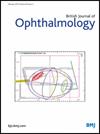形态剥夺性弱视儿童的结构MRI改变:倾向评分匹配的病例对照研究。
IF 3.5
2区 医学
Q1 OPHTHALMOLOGY
引用次数: 0
摘要
形式剥夺性弱视(FDAM)是一种由早期视觉剥夺引起的严重神经发育障碍。本研究使用t1加权MRI来探讨其神经解剖学相关性。方法18例双侧FDAM中国儿童和36例倾向评分匹配的健康中国对照(年龄、性别和平均皮质厚度1比2匹配)接受3.0T t1加权MRI (1×1×1 mm³分辨率)。使用FreeSurfer V.7.3.2对皮质和皮质下结构进行多图谱(desikan - killianyi - tourville, Destrieux,子集Brodmann和Aseg),以及丘脑核和海马-杏仁核子场的专门模块进行分割。采用校正年龄和性别的线性回归模型进行组间比较,并采用Bonferroni校正。结果fdam表现出广泛的结构改变:原发性视力缺陷包括右侧V1变薄(p=3.60×10⁻⁴)和骨膜周萎缩(p=1.03×10⁻⁷),伴有双侧膝状核(p≤1.77×10⁻⁴)和pulvinar核(p≤2.67×10⁻⁴)皮质下变性。语言网络显示左BA44/45萎缩(布洛卡区,p≤9.19×10⁻26),双侧颞平面变薄(对听觉语言至关重要,p≤9.11×10⁻26)。在躯体感觉和跨模式整合区域的破坏被观察到,例如在躯体感觉处理中,表现为BA3a (p≤2.62×10⁻⁴)和左BA3b (p=1.86×10⁻⁴)的双侧萎缩。认知控制网络也表现出变薄(例如,左侧额下沟,p=1.05×10⁻⁸)。皮层下,体积损失影响了双侧白球(p≤1.24×10⁻⁷)和丘脑核(p≤1.11×10⁻⁴)和杏仁核亚结构(例如,左中央核:p=1.22×10⁻⁷)。结论fdam涉及多系统神经干扰,包括初级视觉、语言、体感、认知和情绪调节网络。这些发现突出了这种疾病的复杂性,并激发了进一步的机制研究。本文章由计算机程序翻译,如有差异,请以英文原文为准。
Structural MRI alterations in children with form-deprivation amblyopia: a propensity score-matched case-control study.
AIMS
Form-deprivation amblyopia (FDAM) is a severe neurodevelopmental disorder from early visual deprivation. This study uses T1-weighted MRI to explore its neuroanatomical correlates.
METHODS
18 Chinese children with bilateral FDAM and 36 propensity score-matched healthy Chinese controls (1-to-2 matched for age, sex and mean cortical thickness) underwent 3.0T T1-weighted MRI (1×1×1 mm³ resolution). Cortical and subcortical structures were parcellated using FreeSurfer V.7.3.2 with multiatlas (Desikan-Killiany-Tourville, Destrieux, subset Brodmann and Aseg), alongside specialised modules for thalamic nuclei and hippocampal-amygdala subfields. Linear regression models adjusted for age and sex were employed for group comparisons with Bonferroni correction.
RESULTS
FDAM exhibited widespread structural alterations: Primary visual deficits included right V1 thinning (p=3.60×10⁻⁴) and pericalcarine atrophy (p=1.03×10⁻⁷), with subcortical degeneration in bilateral lateral geniculate (p≤1.77×10⁻⁵) and pulvinar nuclei (p≤2.67×10⁻⁴). Language networks showed left BA44/45 atrophy (Broca's area, p≤9.19×10⁻⁹) and bilateral thinning of planum temporale (critical for auditory language, p≤9.11×10⁻⁶). Disruptions in somatosensory and cross-modal integration regions were observed, such as in somatosensory processing, as manifested by bilateral atrophy in BA3a (p≤2.62×10⁻⁴) and left BA3b (p=1.86×10⁻⁴). The cognitive control networks also exhibited thinning (eg, left inferior frontal sulcus, p=1.05×10⁻⁸). Subcortically, volume loss affected bilateral globus pallidus (p≤1.24×10⁻⁷) and thalamic nuclei (p≤1.11×10⁻⁴) and amygdalar substructures (eg, left central nucleus: p=1.22×10⁻⁷).
CONCLUSION
FDAM involves multisystem neural disruptions spanning primary visual, language, somatosensory, cognitive and emotion-regulation networks. These findings highlight the disorder's complexity and motivate further mechanistic studies.
求助全文
通过发布文献求助,成功后即可免费获取论文全文。
去求助
来源期刊
CiteScore
10.30
自引率
2.40%
发文量
213
审稿时长
3-6 weeks
期刊介绍:
The British Journal of Ophthalmology (BJO) is an international peer-reviewed journal for ophthalmologists and visual science specialists. BJO publishes clinical investigations, clinical observations, and clinically relevant laboratory investigations related to ophthalmology. It also provides major reviews and also publishes manuscripts covering regional issues in a global context.

 求助内容:
求助内容: 应助结果提醒方式:
应助结果提醒方式:


